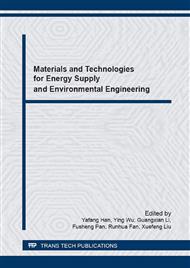p.437
p.445
p.451
p.456
p.460
p.466
p.472
p.479
p.485
Experimental Study on Friction and Wear between Drill Collar and Casing
Abstract:
Casing wear is one of the key issues in the development of oil and gas fields and in the process of drilling operations. In this study, the relationship between hardness and wear resistance of drill collar and casing was studied; thereby the wear conditions between the two materials were improved. Chemical analysis, optical microscopy, hardness test and friction wear test were conducted to study the effects of heat treatment on hardness of the drill collar 4145H and the casing 30Mn5V, and discuss the relationship between hardness and wear resistance of them. The results showed that the materials of drill collar and casing after different heat treatment had varying degrees of wear, both of the respective wear amounts were gradually increasing with the increase of hardness of them, the wear extent of casing material was greater than that of drill collar material. The hardness of casing material was the lowest and its wear resistance was the best when quenching at 880°C and tempering at 630°C. And when quenching at 900°C and tempering at 690°C, the hardness of drill collar material was the lowest and its wear resistance was the best. Therefore, the hardness of drill collar and casing can be improved by changing the heat treatment process to improve the wear resistance, thereby reducing the wear conditions between them.
Info:
Periodical:
Pages:
460-465
Citation:
Online since:
March 2016
Authors:
Keywords:
Price:
Сopyright:
© 2016 Trans Tech Publications Ltd. All Rights Reserved
Share:
Citation:


